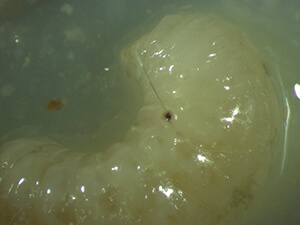
Since publishing a 432-page report on benefits of neonicotinoid insecticides to users and risk to pollinators (Grout et al. 2020; summarized in the September Notes from the Lab: 160(9):1019-1022), I often receive comments from beekeepers who say something like, “Neonics aren’t the problem, varroa is the problem.”
And there’s a lot of truth in that statement; a strong case can be made that problem #1 for beekeepers right now is the varroa mite. But here’s the thing. Stress on organisms doesn’t happen in a vacuum. For example, if you’re 65 and have asthma, in any year other than 2020-2021 you’d probably consider your condition a nuisance that influences your day-to-day life, but in a manageable way. Now throw in the fact that you might contract COVID the next time you’re at the grocery store. That asthma has probably become a lot more serious of a concern with the potential added stress of a deadly respiratory virus, right?
So what about varroa, neonics and Apis mellifera? How does our western honey bee fare when it’s faced with the combined stress of a parasite and pesticide? Can exposure to field-realistic doses of neonicotinoid insecticides impact a honey bee’s immune system and its ability to combat varroa? This is the topic for our thirty-eighth Notes from the Lab, where we summarize “Neonicotinoid Clothianidin reduces honey bee immune response and contributes to Varroa mite proliferation,” written by Desiderato Annoscia and colleagues and published in Nature Communications [2020, 11:5887].
For their study, Annoscia and colleagues first assessed how the neonicotinoid clothianidin impacted immune function in honey bees. This is important since a robust immune response by bees could interfere with food uptake by an ectoparasite such as varroa, whereas a compromised immune response could allow varroa to feed unimpeded.
To assess how clothianidin exposure impacted immune function, the authors dosed bees with several concentrations of clothianidin — 10 or 50 parts per billion (ppb) fed to larvae, or 2, 5, 10, or 20 nanograms/bee (ng/bee) exposed to adults — then compared how the dosed bees responded to a nylon thread (i.e., a small piece of fishing line) inserted into their abdomen (Photos 1-2). The amount of encapsulation/melanization of nylon threads indicates the degree to which a strong immune response is able to be mounted by insects, including honey bees. Expression of two immune function-related genes was monitored during the experiments, as was proliferation of Deformed Wing Virus (DWV).
Since I’m a stickler for highlighting whether or not field-realistic concentrations were used in these types of experiments, it’s worth pointing out that the lowest concentration of clothianidin used in the larval experiments is often found in residues of bee bread and/or nectar in hives that are located in agricultural contexts, such as near corn or soybean fields that are planted with clothianidin-treated seeds. The other concentrations used in the larval/adult bee experiments are less frequently observed in the field, but those concentrations are occasionally found in bee bread/nectar from hives in agricultural areas.
Next, the authors tested whether varroa mites were more fertile and/or fecund on honey bee larvae exposed to clothianidin. To do so, they reared honey bee larvae until the 4th instar, then fed them uncontaminated artificial diet or diet containing 10 ppb clothianidin for 24 hrs (i.e., for the period between the 4th and 5th instar), then introduced one mite per larva and placed them in gelatin capsules in an incubator for 12 days until eclosion (Photo 3). Upon eclosion, each cell was monitored for mite fertility (whether or not the mite produced offspring) and fecundity (how many offspring were produced) and DWV levels were also measured in the eclosed bees.
Finally, using data from their experiments and the literature, the authors created a simple model to predict how differences in mite fertility in clothianidin-exposed vs. unexposed colonies would play out over a growing season. They compared mite counts predicted by their model to mite counts observed in hives placed next to neonicotinoid-treated corn fields vs. hives near untreated fields.
So, what did they find? Does clothianidin impact immune function in bees? Yes. Annoscia and colleagues found that exposure of larvae to either 10 or 50 ppb clothianidin reduced their ability to encapsulate and melanize a nylon thread, downregulated expression of an important immune function gene, and increased ….


